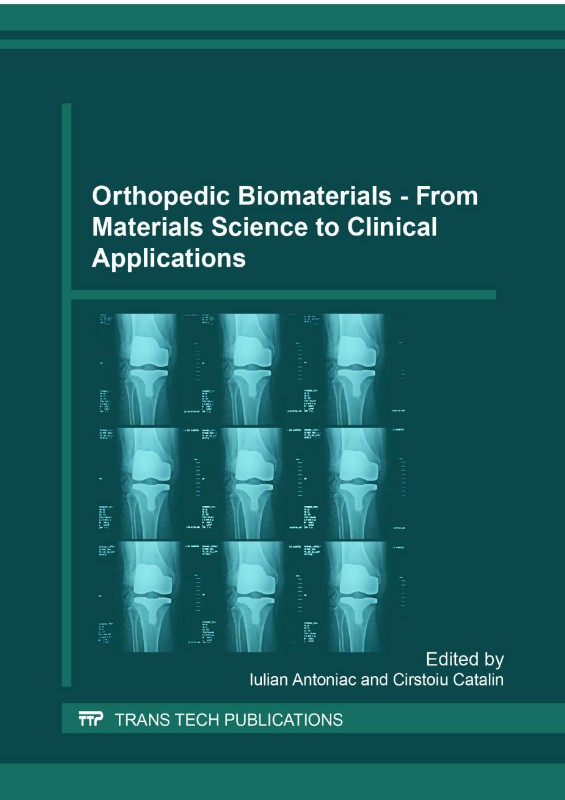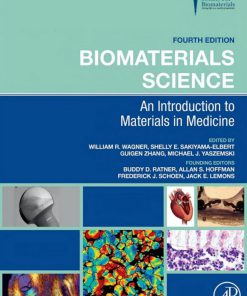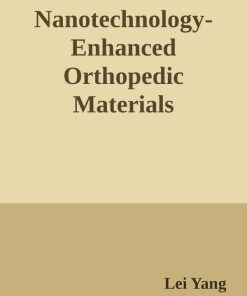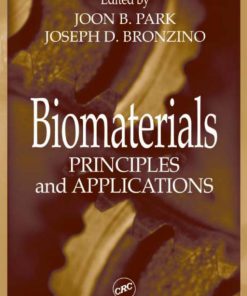Orthopedic Biomaterials – From Materials Science to Clinical Applications 1st Edition by Iulian Antoniac, Cirstoiu Catalin ISBN 9783038355656
$50.00 Original price was: $50.00.$25.00Current price is: $25.00.
Authors:Antoniac, Iulian,Catalin, Cirstoiu , Series:Surgery [35] , Tags:Medicine; Surgery , Author sort:Antoniac, Iulian,Catalin, Cirstoiu , Languages:Languages:eng , Published:Published:Aug 2017 , Publisher:‎ Trans Tech Publications Inc , Comments:Comments:The goal of this special issue is to provide material scientists and orthopedic surgeons with an appreciation of the fundamental aspects of orthopedic biomaterials from the point of view of materials science and elaborate on clinical applications of these materials in orthopedic surgery.
Orthopedic Biomaterials – From Materials Science to Clinical Applications 1st Edition by Iulian Antoniac, Cirstoiu Catalin – Ebook PDF Instant Download/Delivery. 9783038355656
Full download Orthopedic Biomaterials – From Materials Science to Clinical Applications 1st Edition after payment
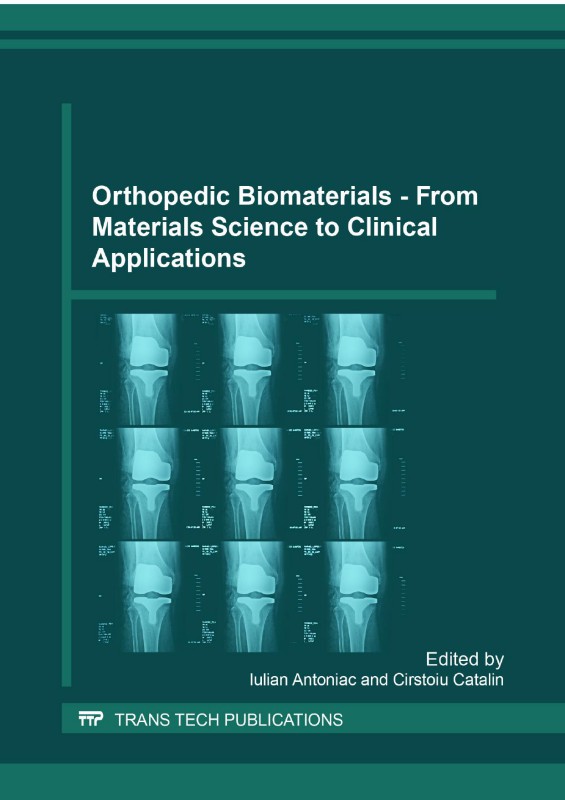
Product details:
ISBN 10:
ISBN 13: 9783038355656
Author: Iulian Antoniac, Cirstoiu Catalin
The goal of this special issue is to provide material scientists and orthopedic surgeons with an appreciation of the fundamental aspects of orthopedic biomaterials from the point of view of materials science and elaborate on clinical applications of these materials in orthopedic surgery.
Orthopedic Biomaterials – From Materials Science to Clinical Applications 1st Table of contents:
Chapter 1: Introduction to Orthopedic Biomaterials
- Definition and Classification of Orthopedic Biomaterials
- Historical Development of Biomaterials in Orthopedics
- Material Requirements for Orthopedic Applications
- Overview of Clinical Challenges and Material Selection
- Future Trends and Innovations in Orthopedic Biomaterials
Chapter 2: Fundamentals of Materials Science for Orthopedic Applications
- Principles of Materials Science
- Mechanical Properties of Biomaterials: Strength, Toughness, Fatigue Resistance
- Biocompatibility and Biodegradability
- Surface Properties: Wettability, Surface Energy, and Adsorption
- Materials Processing and Fabrication Techniques
Chapter 3: Metals in Orthopedic Biomaterials
- Types of Metals Used in Orthopedic Implants: Stainless Steel, Titanium, Cobalt-Chromium Alloys
- Mechanical Properties and Performance of Metal Biomaterials
- Corrosion Resistance and Longevity of Metallic Implants
- Surface Treatments and Coatings for Metal Implants
- Clinical Applications: Hip, Knee, and Spinal Implants
Chapter 4: Ceramics in Orthopedic Biomaterials
- Introduction to Ceramic Biomaterials
- Types of Ceramic Materials: Alumina, Zirconia, Calcium Phosphate
- Mechanical and Biological Properties of Ceramics
- Wear Resistance of Ceramic Implants
- Clinical Applications in Joint Replacements and Bone Defects
- Challenges in the Use of Ceramic Biomaterials
Chapter 5: Polymers in Orthopedic Biomaterials
- Introduction to Polymers and Their Role in Orthopedics
- Types of Polymers Used in Orthopedic Devices: PMMA, UHMWPE, PEEK, PLGA
- Properties of Polymers: Strength, Elasticity, and Biodegradability
- Wear Behavior and Long-Term Durability of Polymeric Implants
- Clinical Applications: Bone Cements, Spinal Implants, and Drug Delivery Systems
Chapter 6: Composites and Hybrid Biomaterials
- Definition and Types of Composite Materials
- Polymer-Metal, Polymer-Ceramic, and Ceramic-Metal Composites
- Benefits and Challenges of Using Composites in Orthopedic Applications
- Design Considerations for Hybrid Biomaterials
- Clinical Applications and Performance of Composite Materials
Chapter 7: Biomaterials for Bone Repair and Regeneration
- Natural and Synthetic Bone Grafts: Materials and Mechanisms of Action
- Biodegradable Bone Scaffolds and Their Applications
- Growth Factors, Stem Cells, and Bioactive Materials in Bone Healing
- Biomaterial Designs for Osteointegration and Osseointegration
- 3D Printing and Additive Manufacturing in Bone Regeneration
Chapter 8: Coatings and Surface Modifications of Biomaterials
- Importance of Surface Modifications in Orthopedic Biomaterials
- Coatings for Enhanced Biocompatibility and Osteointegration
- Types of Coatings: Hydroxyapatite, Titanium Nitride, Polymeric Coatings
- Methods of Surface Modification: Plasma Spraying, Ion Implantation, and Coating Techniques
- Functionalization for Drug Delivery and Antibacterial Properties
- Clinical Impact of Coated Biomaterials
Chapter 9: Biomechanical Testing and Evaluation of Orthopedic Biomaterials
- Testing Methods for Material Properties: Tensile, Compressive, and Shear Testing
- Fatigue and Wear Testing for Orthopedic Implants
- Simulation and Modeling of Implant Behavior in the Human Body
- Preclinical and Clinical Testing of Orthopedic Biomaterials
- Standards and Regulatory Guidelines for Biomaterials Testing
Chapter 10: Clinical Applications of Orthopedic Biomaterials
- Implant Materials in Total Joint Replacement: Hip, Knee, and Shoulder
- Spinal Implants and Materials for Spine Surgery
- Biomaterials in Trauma and Fracture Fixation
- Innovations in Sports Medicine: Ligament and Tendon Repair Biomaterials
- Custom-Made Implants and Patient-Specific Biomaterials
- Advances in Personalized Orthopedic Biomaterials
Chapter 11: Complications and Challenges in Orthopedic Biomaterials
- Implant Failure Mechanisms: Wear, Corrosion, and Fatigue
- Infection and Inflammatory Responses to Biomaterials
- Osteolysis and the Role of Wear Debris in Implant Failure
- Management of Complications in Orthopedic Biomaterial Implants
- Strategies for Improving Biomaterial Longevity and Function
Chapter 12: Future Directions in Orthopedic Biomaterials
- Innovations in Smart Biomaterials and Sensors for Orthopedic Applications
- The Role of Nanotechnology in Biomaterial Development
- Personalized and 3D-Printed Implants
- Bioprinting and Tissue Engineering in Orthopedics
- Regenerative Medicine and Orthopedic Biomaterials
- Environmental Considerations and Sustainable Materials in Orthopedics
Chapter 13: Regulatory and Ethical Considerations in Orthopedic Biomaterials
- Regulatory Framework for Orthopedic Biomaterials
- The Role of FDA and Other Regulatory Bodies
- Ethical Considerations in Implant Development and Patient Safety
- Risk Management in Biomaterial Research and Clinical Practice
- Global Perspectives on Biomaterial Regulation and Standards
People also search for Orthopedic Biomaterials – From Materials Science to Clinical Applications 1st:
from materials science to clinical applications
from science to pharma
what is the application of science to clinical medicine
materials science and medicine
materials science applications
You may also like…
eBook PDF
Nanotechnology Enhanced Orthopedic Materials 1st Edition by Lei Yang ISBN 0857098446 9780857098443

